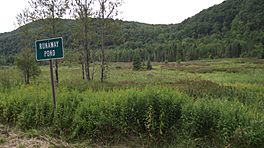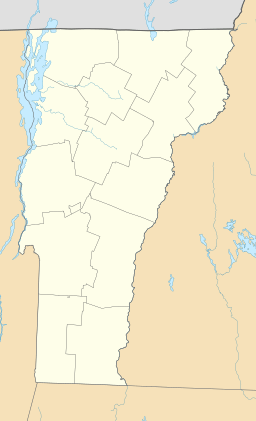Runaway Pond facts for kids
Quick facts for kids Runaway Pond |
|
|---|---|

Site of the "Runaway Pond," Glover, VT
|
|
| Location | Glover, Orleans County, Vermont, United States |
| Coordinates | 44°38′05″N 72°12′42″W / 44.63472°N 72.21167°W |
Runaway Pond is a marsh in Glover, Vermont. It's where a lake called Long Pond used to be. The name "Runaway Pond" comes from a huge flood that happened in 1810. During this event, people tried to move some water from Long Pond. But instead, the lake's edge broke, and all the water suddenly rushed out into the Barton River without anyone being able to stop it.
This historic site is about 5 miles south of the main village of Glover today.
Contents
What Was Long Pond Like?
Long Pond was a very large body of water. Experts believe it held almost 2 billion gallons of water!
It was about 1.5 miles long and half a mile wide. The lake was usually 80 to 100 feet deep, and in the middle, it was even deeper, around 150 feet.
With a surface area of 480 acres, Long Pond was much bigger than what we would call a lake today.
The Day the Lake Ran Away
The Plan Goes Wrong
On June 6, 1810, it was a very dry summer. The Barton River, which powered the mills in Glover, was running very low. A local mill owner named Arron Willson needed more water for his mill. So, about 60 men and boys gathered to help. They tried to dig a new path for some water to flow from Long Pond into the Barton River.
But their plan went wrong. Instead of just a little water, the entire bank of the pond broke open. This caused all the water from Long Pond to flood the Barton River Valley.
The Flood's Journey
The valley drops about 600 feet from Runaway Pond to Orleans. This means the water rushed downhill very quickly, dropping about 40 feet for every mile it traveled.
The first rush of water carried away trees and huge rocks. These items piled up, creating a giant logjam. This jam temporarily stopped the flood. But then, the water pressure behind the jam built up so much that it broke through again. This kept happening as the flood moved down the valley towards Barton.
A Heroic Rescue
One of the workers, Spencer Chamberlain, ran ahead of the flood. He reached Arron Willson's wife, who was working at the mill, just in time to save her. Luckily, no one lost their life in this big flood.
All the water from Long Pond emptied out in just 1 hour and 15 minutes. However, the mud continued to flow for many hours after that. The floodwaters reached Lake Memphremagog in only 4 hours. Reports say the water level in Lake Memphremagog rose by 1 foot because of the flood.
After this event, the place where the lake used to be was forever called "Runaway Pond."
What We See Today
The Runaway Pond event is a clear example of how human actions can accidentally cause big changes to nature.
You can still see the effects of the flood today. For example, at Clark Pond, which is just north of the Runaway Pond site, and in other parts of the Barton River valley.
Every year on Glover Day (the last Saturday of July), people remember Spencer Chamberlain's brave act. They hold a 5.5-mile road race that follows the exact path the flood took.
In June 2010, the Glover Historical Society held a special celebration to mark 200 years since the Runaway Pond event.


